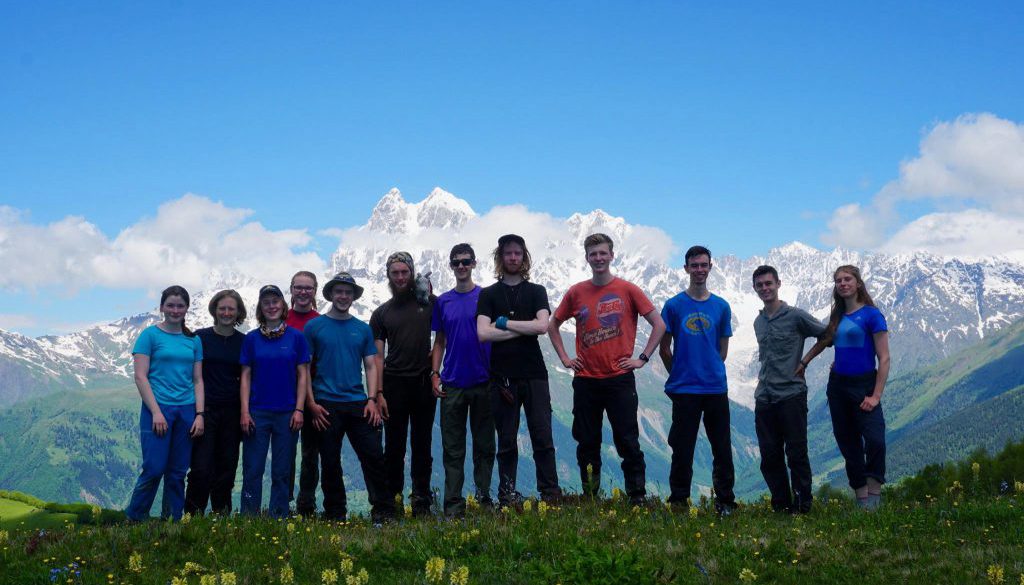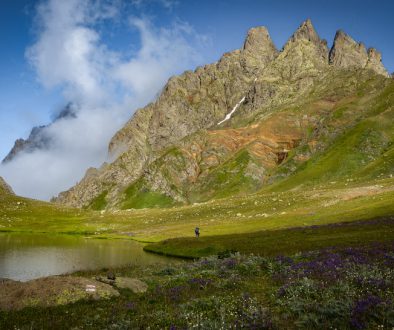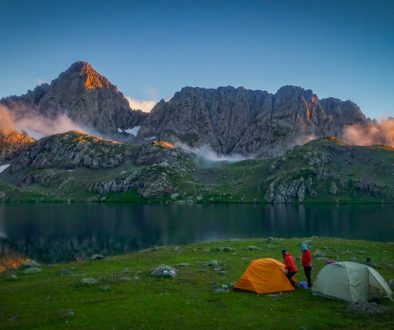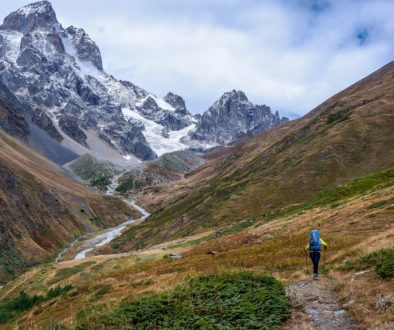Trip Report: University of Bristol students on the TCT
Catherine Easdon, of the University of Bristol Expedition Society, led a trip to Svaneti earlier this summer and collected data for the TCT project. She has kindly written this account of the trip with helpful advice for those planning similar treks.
By Catherine Easdon
2am, 19th June. Sleepily peering out of the window as we approached Kutaisi, I wondered what on earth I’d let myself in for. Over a year earlier, Tom’s blog post about this strange new project of his called the “TCT” had planted an idea in my head and somehow – all the planning and preparation had blurred together into little more than a blink of an eye – that idea had turned into reality. Now here I was with 12 friends from UBES (the University of Bristol Expeditions Society) in tow, all trusting me to lead them 200km through the Greater Caucasus on my very first visit to the region. To say I was nervous would be an understatement!
The plan was to test out the Svaneti section of the TCT as a backpacking route and gather updated route data for the project. With the year’s trail-building about to begin, we also needed to identify trail sections which had suffered damage over the winter and needed maintenance. But there was still so much uncertainty in the plan and it was driving me crazy. Before this trip, I’d always travelled to places where so much information was available beforehand that almost everything – transport, accommodation, food resupplies – could be certain in advance. Gathering information for this trip, however, had been significantly more challenging. Most of the transport arrangements were still unknown, and we were going to have to carry many days’ worth of food as I’d found no info on which of the small villages had shops. To make matters worse, just a few days beforehand I’d had to completely change the route! I’d originally intended to start the hike with the beautiful Tobavarchkhili Lakes and then hike west to east from Khaishi to Ushguli. The amount of snow there might be up at 3000m around the lakes had always been a concern, but we were prepared to hike with ice axes and crampons. A last-minute update about the snow conditions however (“it’s very deep, you better bring snowshoes”) had convinced me that it would be safer to reverse the route, hiking east to west instead in the hope that by the time we reached Khaishi the snow would have melted enough to attempt the Toba Lakes hike.

As it turned out, we were right to carry lots of food, as we saw no sign of shops in most of the villages. Mestia has a supermarket and many shops, so it’s the place to stock up before your hike. There’s also some food available in Ushguli (mostly in guesthouse cafés), Khaishi and Nakra (although we never saw the single shop there open). If you’re staying in guesthouses they will provide meals for you, and many families will be happy to sell you food such as fresh bread and cheese if you ask. Aside from food though, most of my fretting was unwarranted. Transport in particular was much easier to arrange than I expected – just ask at the main square in Mestia and you can arrange a lift to/from anywhere you might want to hike.
From the airport staff who greeted us at the terminal with free bottles of Georgian wine (I’m still not exactly sure why, but I’m not complaining) to the riders in Ushguli who saw us contemplating a particularly sketchy river crossing and offered the entire group lifts across on horseback, we were welcomed with kindness throughout the trip (plus a little concern for our sanity for being mad enough to backpack!). It was a fantastic adventure and an amazing chance to learn about Georgia and the Caucasus, which I’m ashamed to say I knew very little about before discovering the TCT. I just wish I’d learnt more Georgian before coming – many people did speak some English, and for that I was very grateful, but just as many didn’t and I would have loved to chat with them about their lives and hear their thoughts about the TCT. I’ll definitely be back (we never made it to Toba Lakes, so I have unfinished business!) and this time I promise to have learnt more vocab…

I have so many great memories from our three weeks in Georgia, but it’s the little unexpected moments that will stay with me forever. Reaching the top of Chkhunderi Pass and realising as we saw the Adishi glacier for the first time that the ominous sounding ‘thunder’ we’d been hearing was actually great walls of ice crashing down from the glacier. Ending up trapped between two groups of stampeding cows on a day hike to Shdugra waterfall, with one group heading for the bridge and another being chased back across it by a border guard – utterly surreal! The pure bliss of being warm and dry, sitting chatting and toasting our socks round a campfire after several long days of hiking in the rain. The thrill of crossing fast-flowing rivers on horseback at Ushguli and Adishi – it was my first time ever riding a horse! And the stunning panorama of 4000m and 5000m peaks from our camp at Koruldi Lakes, the summits glowing in the evening light.
Inevitably, not everything went according to plan and there were some very challenging days, but sometimes the plan falling apart made for wonderful surprises. Our last camp site is a great example. On our final evening, we were still 7km from our goal for the day (Nakra) and the whole group was struggling. There was no question about it – we couldn’t go any further. I’d just resigned myself to an uncomfortable night, probably perched awkwardly on a slope at the side of the path, when we turned a corner and saw an incredible camping spot: a huge meadow with stunning views of the hills lining the valley all the way into Abkhazia and beyond. We couldn’t have asked for a better final night in the mountains – the sunset that evening is one of my favourite memories of the whole trip, and yet if things had gone ‘according to plan’, we’d have just marched straight past and missed it!

I’d like to say a huge thank you to the University of Bristol’s Knowlson Trust and Alumni Foundation, who provided us with grants towards travel costs and GPS equipment – without their help this trip wouldn’t have been possible. And thanks again to Tom, Paul and the whole Georgia TCT crew for all the advice and for kindly hosting us at the Mestia HQ – the first few days were a bit overwhelming, but you really made us feel at home!
Now it’s your turn!
I hope this post has inspired you to consider a TCT trip of your own, whether to Svaneti or to one of the other regions of the trail. If you’d like to find out more about our Svaneti hike, we have a full trip report here with a day-by-day diary and logistical details (such as maps, prices and the guesthouses we stayed at), which I hope will be helpful if you’re planning a trip of your own to Svaneti.

Regarding backpacking the route: the mountains in Svaneti really are astonishingly steep, which makes backpacking in the region very physically demanding. Clinging onto tree roots to keep ourselves upright was a pretty normal occurrence on the uphill climbs! I’d recommend only considering backpacking the route if you have previous backpacking experience and a very good level of fitness. Bring along a GPS device (there are some great smartphone apps available like MAPS.ME and OsmAnd if you don’t have a dedicated GPS)
That aside, it’s an amazing backpacking route. There are plenty of wild camping spots and water sources along the trail, and the stunning views make all those uphill struggles worth it. A great alternative if you fancy a less demanding trip is to stay in guesthouses in the valleys so you can hike with a much lighter pack, meet local people and learn more about Georgia – oh, and maybe sample the odd khachapuri and chacha shot!







November 15, 2017 @ 8:33 pm
Invaluable info here. Thank you.